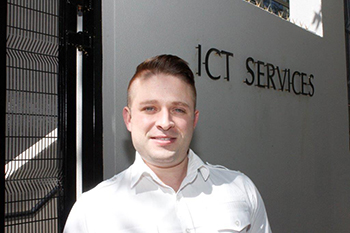
Andrew Jusjong, Chief Officer: ICT, one of the main drivers
of PeopleSoft at the UFS.
Photo: Rulanzen Martin
At the beginning of his term, the Rector and Vice-Chancellor of the University of the Free State (UFS), Prof Francis Petersen, mentioned to parents and prospective students the importance of the UFS being recognised globally as innovators.
This month, Information and Communication Technology Services (ICT Services) were recognised by Oracle as one of the PeopleSoft Innovators at the Oracle OpenWorld (an international conference regarding all Oracle products) for deploying student self-service, using PeopleSoft Campus Solutions’ new Fluid user interface.
Andrew Jusjong, Chief Officer: ICT, says, “This solution allows dynamic administrative setup regarding available degrees, customised messages, dynamic required degree-specific documentation, and integration with the Applications and Admissions module.” He says it also includes self-service functionality that allows students to track the status of their applications, and provide additional documentation required for their study choices.
“The UFS is the only innovator in the European, Middle-Eastern and African region. Considering that the development team at the UFS is much smaller than their international counterparts, this illustrates that we do not have to stand back for our international peers regarding service delivery and the quality of service to our customers,” he says.
The PeopleSoft Innovator awards are presented to companies that are taking advantage of the latest capabilities and technologies provided by Oracle PeopleSoft in order to transform their businesses and their IT practices, while also providing benefits to the business and end users. The UFS has been making use of PeopleSoft applications since 2004. It currently makes use of three applications:
- PeopleSoft Financials for procurement, budgeting, billing, asset management, general ledger, journals, provisioning, payroll, commitment control, ad hoc claims, travel and expenses, and maintenance management.
- PeopleSoft Human Capital Management for HR data processes, recruitment, workforce management, remuneration management, leave management, employee self-service, and other HR activities; and
- PeopleSoft Campus Solutions for student lifecycle management, applications and admissions, curriculum management, programme enrolment, student records, student financials (accounts), financial aid, graduation, alumni management, graduate research management, residences, and student self-service.
In the Higher Education sector, PeopleSoft is being used by over 900 campuses in 34 countries, across six continents. “This means that recognition was given to the university on a global platform,” says Jusjong.